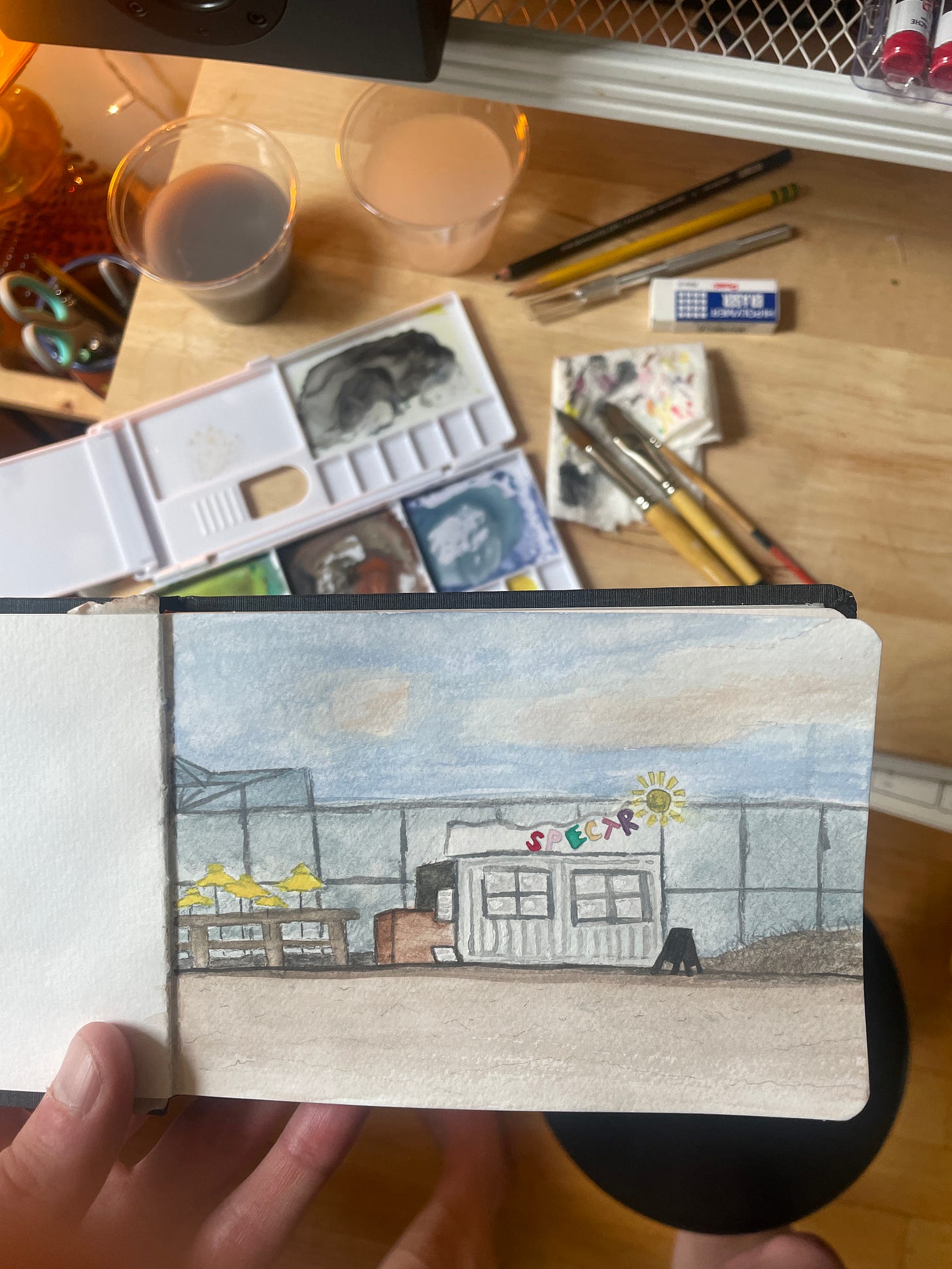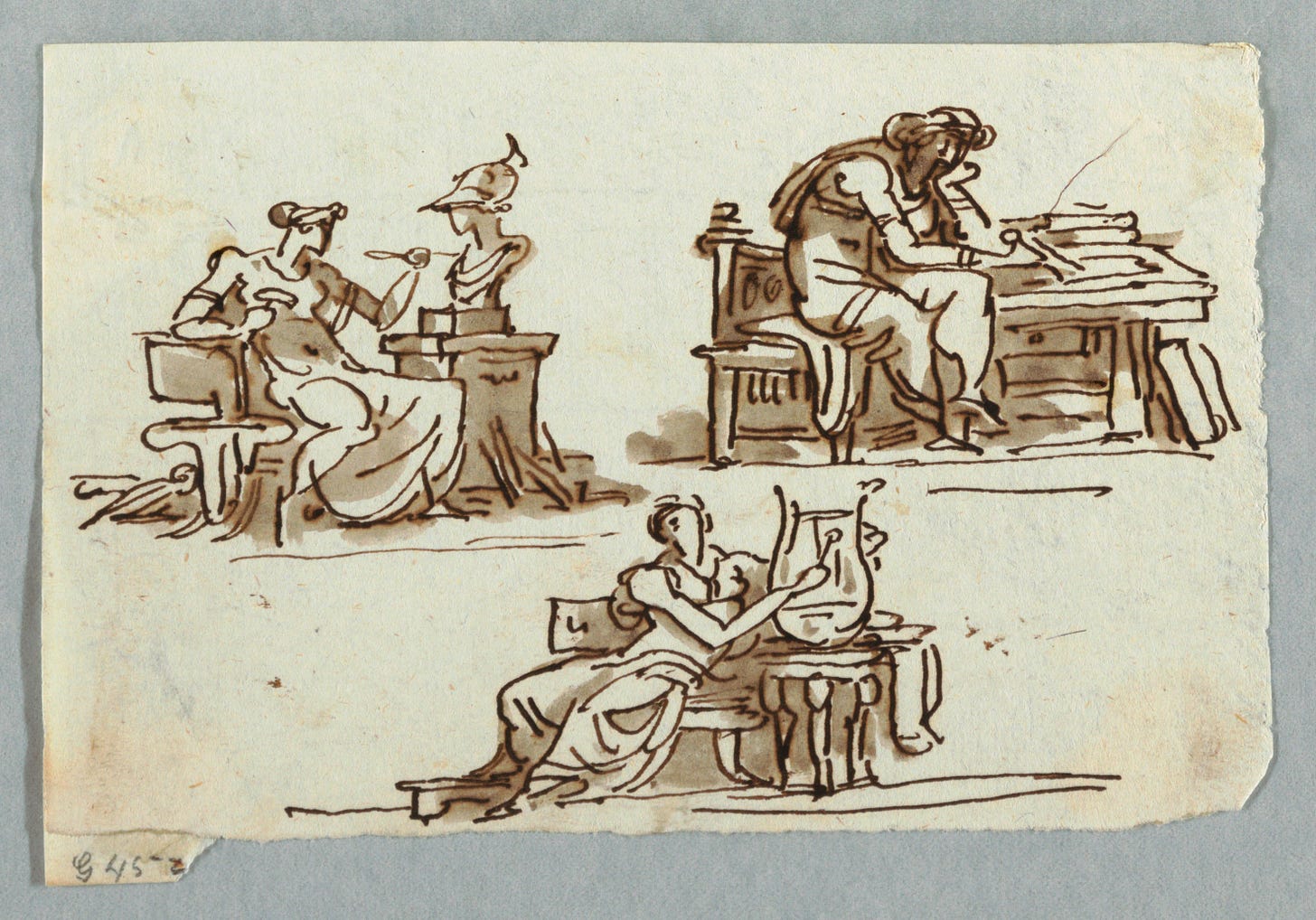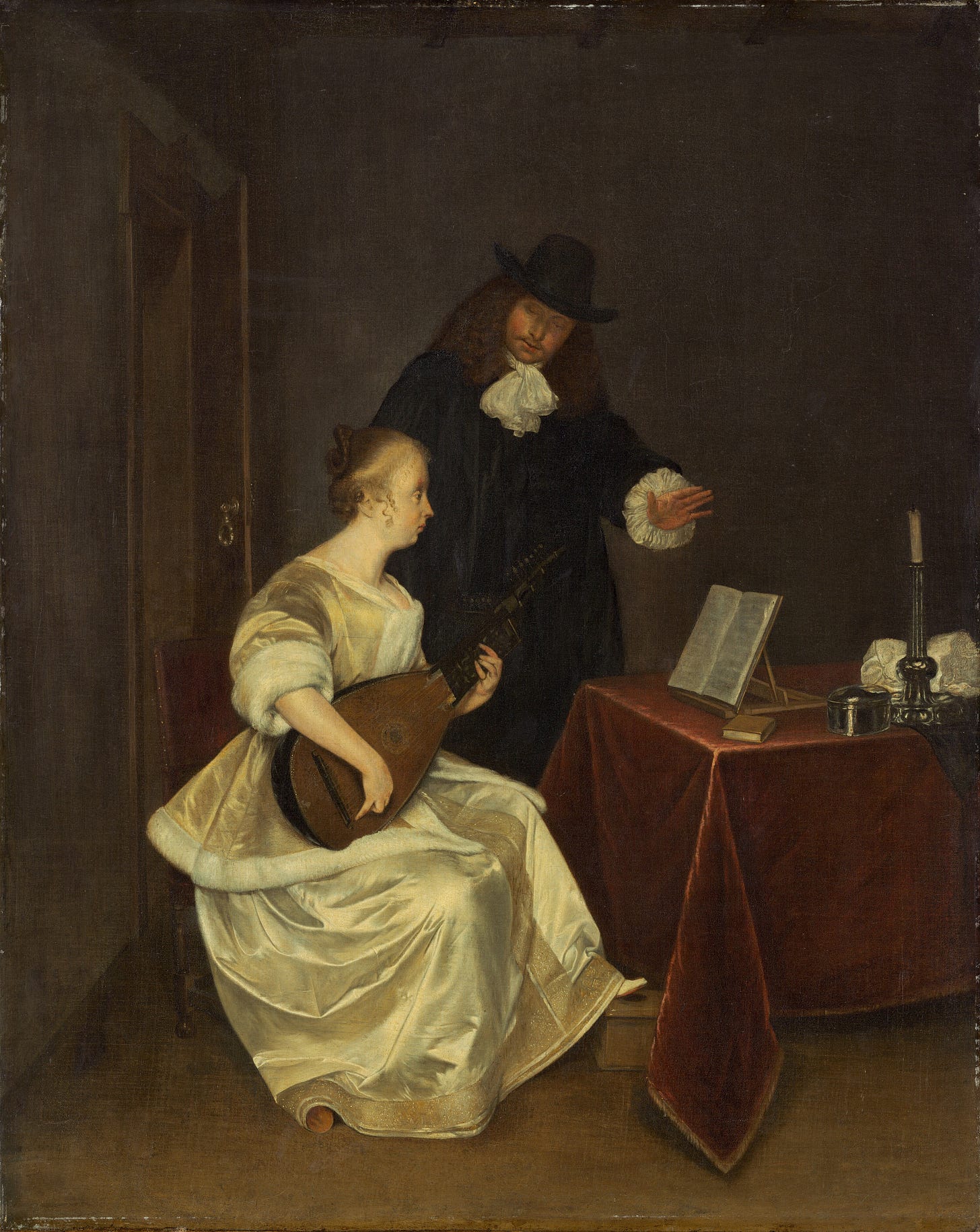The creative palette
Last year I took up painting. Visual art has been an interest of mine since I was young, but it fell by the wayside for a while as I began seriously pursuing music.
At first I began mostly experimenting—I knew a bit about composition and color theory from taking studio art in high school, and I was also looking for a hobby rather than a serious discipline.
I started following a few painters on youtube—my personal favorite was James Gurney, the creator of the Dinotopia book series as well as a background painter for Fire & Ice.
What intrigued me most about Gurney is that he prepared his palette with only a few colors, even when painting vivid subjects, to ensure a unified looking piece. In his own words, “every color you mix is already related.”
This intentionally limited approach already caters to my aesthetic sensibilities, and after practicing it some I’ve found that it holds very true in visual art. More so, I’ve found it speaks to a broader truth I’ve discovered in practicing music—self prescribed constraints guide us to the heart of whatever it is we are working on.
My last piece was on basic major and minor scale and chord fluency. Continuing with the painting metaphor, this is akin to learning how to deal in your primary red, yellow, and blue colors. If you are still working on your basic chords and scales, start here.
This weeks piece is a deeper and more nuanced study of the same idea—leaving the greens, browns, and other mid-tones off the palette and instead working to produce those tones with a palette of four or five colors.
This piece will provide a framework for deeply exploring tonalities with the aim of uncovering melodic and harmonic conventions to advance your ability to improvise and compose.
This piece will include a PDF of a practice method I’ve developed for free download. If you have the means to support my work consider becoming a paid subscriber so I can continue to publish resources of this nature.
Musical gravity
In the west, we have a 12-tone system consisting of the notes A-G and the requisite sharps and flats. Each of these 12 tones can act as a tonal center, referred to as a tonic.
A tonic is a musical home base—a tone from where you may start, depart from, and return to through creative means to build tension and release. The development of this aesthetic principle can be traced as far back as the Baroque era.
From every tonic, that is each of the 12 tones, we have the ability to arrange pitches in various ways that form tonalities. Major, natural minor, harmonic minor, melodic minor, the greek modes, pentatonic scales, and many more are examples of various tonalities.
From a tonality we can derive melodies and chords, and with creative intent we can form these musical devices into actual pieces of music.
Each and every tonality has one thing in common—musical gravity, meaning a system of tonal relationships, attractions and repulsions, and tension and release. This is what musical theorists mean when they use the term function—every pitch in a tonality contributes to tension and release.
So where does all this leave the creative musician looking to develop the ability to improvise and compose? Essentially, our job becomes to learn how to convey tension and release through the means of various tonalities.
You could pick up a robust book of scales and try to simply shed out each and every scale, but I’ve found in my own journey, and in the journey of my students, that this alone doesn’t yield the ability to create within a tonality. Rather, I’ve found robust exploration of a tonality is the key to accessing creative material.
Practice Methodology
Compared to my last piece, this practice plan is far less prescriptive.
Instead, I’ll be establishing a framework, giving a few examples, and encouraging you to explore in your own ways. There are two resources I would encourage using:
A drone to help ground your intonation and so that you may hear the relationships inside of each tonality.
A metronome to ground your timing.
In the following practice roadmap, there are four domains. These domains are intended to be moved through in sequence—begin with the first domain, and only move on to domain 2 once you feel secure and effortless in domain 1. Some folks will spend a day in the first domain before moving on to the second. For others, it may be a week or a month. There is no right timing—the most important part is committing to yourself and the process!
One more note: All of the examples I provide are using the C Major scale for ease of communication of ideas. The concept of this roadmap can be applied to nearly any tonality—D harmonic minor, G dorian, B altered dominant, and most other common scales.
Now, let’s take a look at the four domains of this practice roadmap…
Domain 1: Basic scale fluency
This is the more straightforward part as well as the entry point for this practice methodology. In this domain, you’ll work out the basic notes of each scale before you dive to deep into exploration. There are three particular variations I use when working on most 7-note scales:
The basic scale ascending and descending
The scale in 3rds, ascending and descending
The scale in 4ths, ascending and descending
Of course, you could go deeper with more basic variations, but I have found these three iterations to cover the basics. Here are the instructions for carrying out this level of the practice:
Turn on a metronome at 60 BPM as well as a drone on the root note of your tonality of choice.
Begin with the basic scale, ascending and descending, using quarter notes. Continue until you can play this smoothly and with minimal effort.
Double the pace with eighth notes, continuing until you can play this smoothly and with minimal effort.
Once more, double the pace with sixteenth notes, continuing until you can play this smoothly and with minimal effort.
Repeat steps 2-4 for the scale in 3rds and 4ths.
Domain 2: Melodic Fluency
In this domain, you’ll use melodic patterns to advance your study of the tonality. I have included 3 examples to prompt your exploration—feel free to use these, but consider using them as prompts to create your own melodic primers for scale exploration. Here are the instructions for carrying out this level of the practice:
Turn on a metronome at 60 BPM as well as a drone on the root note of your tonality of choice.
Pick one melodic pattern per practice session—whether it be one included in the exercise, or one you created. Play the pattern in quarter notes, ascending and descending. Continue until you can play this smoothly and with minimal effort.
Double the pace with eighth notes, continuing until you can play this smoothly and with minimal effort.
Once more, double the pace with sixteenth notes, continuing until you can play this smoothly and with minimal effort.
Here is an example of a pattern you might utilize:
Domain 3: Harmonic Fluency
In this domain, you’ll use harmonic patterns to advance your study of the tonality. I have included 6 examples to prompt your exploration—feel free to use these, but consider using them as prompts to create your own harmonic primers for scale exploration. Here are the instructions for carrying out this level of the practice:
Turn on a metronome at 60 BPM as well as a drone on the root note of your tonality of choice.
Pick one harmonic pattern per practice session—whether it be one included in the exercise, or one you created. Play the pattern in quarter notes, ascending and descending. Continue until you can play this smoothly and with minimal effort.
Double the pace with eighth notes, continuing until you can play this smoothly and with minimal effort.
Once more, double the pace with sixteenth notes, continuing until you can play this smoothly and with minimal effort.
Here is an example of a pattern you might utilize:
Domain 4: Creative Exploration
In this domain, you’ll use melodic improvisation as well as harmonic progressions to advance your study of the tonality. For this step, you may choose whether or not to use a metronome. For melodic exploration, it is sometimes easier to flow more freely and follow your own timing of ideas.
Here are the instructions for carrying out melodic exploration practice:
Turn on a drone on the root note of your tonality of choice.
Improvise!
Option 1: Play a short improvised melody on your instrument. Then, sing it back to yourself. Repeat the same melody until you can sing it accurately. Continue and repeat this process with new melodies.
Option 2: Sing a short improvised melody within the tonality. Then, figure it out on your instrument. Repeat the same melody until you can play it as accurately as you sang it. Continue and repeat this process with new melodies.
Here is an example of what melodic exploration might look like:
Here are the instructions for carrying out harmonic exploration practice:
Turn on a drone on the root note of your tonality of choice.
Write out a chord progression using the given chords of your tonality. This can use as few or as many chords as you wish.
Play through the chord progression in chords and/or arpeggios depending on the instrument). Begin in root position, and once you are comfortable try playing through it with chord inversions that demonstrate smooth voice leading.
Here is an example of what harmonic exploration might look like:
Tonality Practice Roadmap
The above section is merely a brief explainer of the full practice plan. If you’re looking to dive in, here is the full exercise available for free download:
If you have any questions, leave a comment below and I will do my best to guide you in your own practice!
What’s Next
You can expect a video essay version of this piece with demos of each step next Wednesday, May 14th.
Until then—Good luck, and happy practicing!














Why are you so amazing? Thanks in advance! Can’t wait to sit in front of my piano.